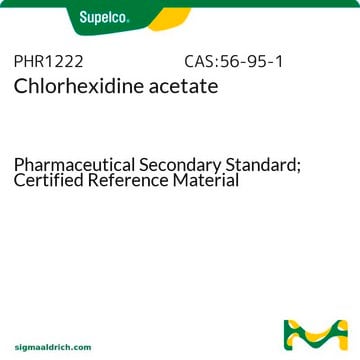C9394
Chlorhexidine digluconate solution
20% in H2O
Synonym(s):
Bis(p-chlorophenyl)diguanidohexane digluconate, 1,6-Bis(N5-[p-chlorophenyl]-N1-biguanido)hexane; 1,1′-Hexamethylenebis(5-[p-chlorophenyl]biguanide)
About This Item
Recommended Products
form
liquid
concentration
20% in H2O
solubility
water: soluble 50 % (w/v)
density
1.06 g/mL at 25 °C (lit.)
antibiotic activity spectrum
Gram-negative bacteria
Gram-positive bacteria
Mode of action
cell membrane | interferes
storage temp.
2-8°C
SMILES string
OC[C@@H](O)[C@@H](O)[C@H](O)[C@@H](O)C(O)=O.OC[C@@H](O)[C@@H](O)[C@H](O)[C@@H](O)C(O)=O.Clc1ccc(NC(=N)NC(=N)NCCCCCCNC(=N)NC(=N)Nc2ccc(Cl)cc2)cc1
InChI
1S/C22H30Cl2N10.2C6H12O7/c23-15-5-9-17(10-6-15)31-21(27)33-19(25)29-13-3-1-2-4-14-30-20(26)34-22(28)32-18-11-7-16(24)8-12-18;2*7-1-2(8)3(9)4(10)5(11)6(12)13/h5-12H,1-4,13-14H2,(H5,25,27,29,31,33)(H5,26,28,30,32,34);2*2-5,7-11H,1H2,(H,12,13)/t;2*2-,3-,4+,5-/m.11/s1
InChI key
YZIYKJHYYHPJIB-UUPCJSQJSA-N
Looking for similar products? Visit Product Comparison Guide
Application
Biochem/physiol Actions
Other Notes
related product
Signal Word
Danger
Hazard Statements
Precautionary Statements
Hazard Classifications
Aquatic Acute 1 - Aquatic Chronic 2 - Eye Dam. 1
Storage Class Code
12 - Non Combustible Liquids
WGK
WGK 3
Flash Point(F)
Not applicable
Flash Point(C)
Not applicable
Personal Protective Equipment
Certificates of Analysis (COA)
Search for Certificates of Analysis (COA) by entering the products Lot/Batch Number. Lot and Batch Numbers can be found on a product’s label following the words ‘Lot’ or ‘Batch’.
Already Own This Product?
Find documentation for the products that you have recently purchased in the Document Library.
Customers Also Viewed
Our team of scientists has experience in all areas of research including Life Science, Material Science, Chemical Synthesis, Chromatography, Analytical and many others.
Contact Technical Service












